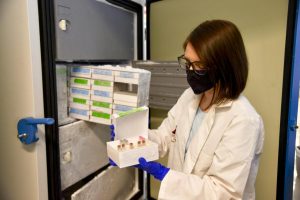On February 28, 2021, I had an insightful interview with Dr. Nicole Wanner, postdoctoral researcher and Project Lead on the newly published study from University of Minnesota on the Long-term Effects of CBD Use During Pregnancy.
If you wish to re-publish this story please do so with following accreditation
AUTHOR: Heather Allman
PUBLISHER: CANNABIS LAW REPORT
Interview with Dr. Nicole Wanner, Project Lead on the newly published study concerning CBD Use During Pregnancy by the University of Minnesota
On February 28, 2021, I had an insightful interview with Dr. Nicole Wanner, postdoctoral researcher and Project Lead on the newly published study from University of Minnesota on the Long-term Effects of CBD Use During Pregnancy.
Cannabis Law Report: Why do you love your work?
Dr. Nicole Wanner: One of the things I love about science is the feeling of finding out something that is totally new – you work for months to make sure everything is ready, you learn to do complicated techniques, and one day you finally get your data and you have brand new information about a question that’s important for human health.
We do preclinical research and work with mice, meaning that the results aren’t immediately applicable to humans, but these projects are a vital first step in working towards our ultimate goal of helping people make informed decisions about topics like cannabis and CBD use.
CLR: What was your personal intention initially jumping into the research? Why study CBD, or the Cannabis plant?
Dr. Nicole Wanner: First, I was intrigued by the massive gaps in our scientific knowledge about cannabinoids resulting from decades of prohibition. Cannabis use and legalization are increasing rapidly but we have an incomplete understanding of its effects in the brain and body.
This is particularly true for CBD, which is being used in the absence of THC by large numbers of people for the first time.
Second, cannabinoids like CBD and THC act on many receptors and other targets in the brain. Because of these many targets cannabis has a wide range of potential therapeutic applications. This flurry of activity also has the potential to cause problems during development.
However, since a delicate balance is required for the brain to grow and develop in a healthy way. I am very interested in these dual roles for CBD – therapeutic for adults, but potentially disruptive in the womb and during early life.
CLR: Why specifically do you think the ‘CBD Use During Pregnancy Study’ needed to be conducted?
Dr. Nicole Wanner: Using CBD alone (without THC) is a very new phenomenon and is being recommended for a wide variety of ailments such as pain, inflammation, anxiety, and others.
Science is playing catch-up to learn whether these claims are based in fact, and there is growing evidence from animal and human studies that CBD may be beneficial for several of these concerns either alone or in combination with existing medications.
What myself and the director of the study, Dr. Christopher Faulk, found particularly concerning, however, is the lack of information about the safety of CBD during pregnancy. Pregnancy is a crucial time for brain development and the setting of gene regulatory marks we study called DNA methylation, which help determine the “when, where, and how much” of the way genes work.
Genes provide written instructions for all of the body’s functions, and DNA methylation can subtly change the message in a way that matters for our health. For a given gene it’s similar to the difference between ending a sentence with a period or with an exclamation point.
Factors like the food our mothers eat or the drugs they consume can impact these marks in ways that affect the growing brain for years, potentially all the way into adulthood.
DNA methylation has been shown to be important in a number of neuropsychiatric conditions such as autism, substance use disorder, schizophrenia, and others, so we were interested in learning about 1) how CBD during pregnancy affects the anxiety and memory behavior of mouse offspring as adults, as well as 2) how it changes these marks in the brain.
We found that CBD during pregnancy affected both the memory and anxiety behavior of adult offspring and also changed thousands of DNA methylation marks in the brain.
Animal studies are not perfectly translatable to humans, but this was an important first step in understanding how CBD during development could affect long-term psychological health.

Project Lead Nicole Wanner examines mouse DNA at the Andrew C. Boss Laboratory of Meat Science on Friday, Jan. 29. Wanner’s research focuses on how CBD oil affects pregnant mice and their offspring. (Photo credit: Emily Pofahl)
CLR: Tell me about your year to date, expanding on ‘CBD Use During Pregnancy Study’, 2020, and your role in the Cannabis research landscape development?
Dr. Nicole Wanner: Early in 2020 we finished up behavior testing and collecting samples, and then I was fortunately able to spend time at home writing and editing the manuscript for the study to be published. Publishing scientific manuscripts is a long process that includes anonymous review by other scientists to ensure the work is adequately rigorous and high quality, so I also got to incorporate reviewer comments to make the writeup of our results as clear and thorough as possible.
During that process we also started a second study looking at the effects of CBD during pregnancy on adolescent offspring. Adolescence is another important period of brain development and CBD purchasing age rules can be difficult to enforce, particularly online, so we felt that it was a logical next step for our CBD research.
CLR: How do your past professional experiences and successes help you today in the modern CBD/Cannabis space as a researcher?
Dr. Nicole Wanner: I am still very much in a learning role as a postdoctoral researcher, but I think my training as a veterinarian has helped me to think critically about interesting questions in cannabis research and given me the skills to investigate them.
CLR: How does this study add value to the medical cannabis sphere?
Dr. Nicole Wanner: Since our study was in animals we can’t make direct claims about what CBD during pregnancy does in people, but I think our results should encourage caution for using CBD or cannabis during pregnancy.
There are already a number of studies showing negative outcomes for THC during pregnancy, and based on our early data it seems that the story with CBD might be similar. Both CBD and THC interact with a number of chemicals and receptors in the body that play a role in many functions including brain development.
Our findings certainly don’t discount the medical applications of cannabis and CBD, but our research group hopes to help users make the best possible decisions regarding cannabis products and starting a family.
CLR: Briefly tell me about your goals in the cannabis industry with this new study. What is your foremost goal for ‘CBD Use During Pregnancy Study’?
Dr. Nicole Wanner: Dr. Faulk and myself have no financial stake in the cannabis industry, so our goal is purely to gain new knowledge about these compounds and help the public make informed decisions about their own use.
CLR: What is the “mission statement” of the study, so to speak, if one existed?
Dr. Nicole Wanner: The mission of our study was to learn about how CBD during pregnancy affects the brain of adult offspring – our study was done in mice, but the human equivalent would be a mother using CBD daily during pregnancy and breastfeeding and then studying the effects in her 25-year-old adult child.
One reason that animal studies like ours are a useful first step is that we can control a lot of the factors that complicate the results of human studies – the animals ate the same diet and received the same amount of CBD in the absence of other substances like tobacco and alcohol. The mice are also genetically identical, which simplifies our gene regulatory analyses and removes the influence of genetics on behavior.
Animal study results can be used to inform the design of larger human studies, which are needed to definitively determine whether the effects we see in animals are likely to impact people in a significant way.
CLR: What was the most interesting part of researching this study?
—of publishing this study?
Dr. Nicole Wanner: One of the most interesting results to us was that the effects on memory and anxiety behavior were specific to female offspring; male offspring exposed to CBD during development had normal behavior.
This finding is important because several psychiatric conditions affect men and women differently or at different rates.
Understanding the mechanisms that control those differences is key to coming up with new and effective treatments. For a long time in the past researchers only looked at male mice, so a result like ours might have been missed.
CLR: The biggest challenges to researching and publishing a new cannabis study, especially in the middle of a pandemic?
Dr. Nicole Wanner: During the time we conceived the study the only FDA-approved form of CBD, Epidiolex, was DEA Schedule V. We wanted to use the best source of CBD we could get for the study, but this also meant that we had to go through a large number of approval steps and keep very detailed records.
Shortly after the study concluded, Epidiolex was de-scheduled, which has made performing our follow-up study a bit easier. Regarding publishing, it seems that a larger number of scientific journals are becoming interested in CBD and cannabis studies, where in the past only a small number of journals would publish them.
The pandemic slowed down our progress on the study, however, we were fortunately able to perform a lot of data analysis from home while the University of Minnesota worked on reopening plans.
CLR: In your opinion, what are the biggest challenges Cannabis faces or has faced?
Dr. Nicole Wanner: There are a number of challenges, but one that I’ve noticed while learning about the scientific cannabis community is that there is a tendency to want cannabis to be “all good” or “all bad”.
Some groups find nothing but benefits while others find nothing but problems, and I think this duality is harmful to understanding cannabis in a holistic way.
Our study found mixed outcomes for CBD during pregnancy (some behaviors were improved while others got worse) and I think allowing both to be true is extremely useful.
Cannabinoids are powerful compounds that can help or harm depending on a huge variety of factors, and that’s part of what fascinates me about them. Some people in the cannabis arena are hesitant to admit that cannabinoids are not beneficial in every situation, while others read about one negative effect and decide that they have no medical value.
There are many existing medications that can have positive or negative effects depending on dose, timing, genetic background, and dozens of other factors, and my hope is that we seek to understand cannabis products with the same degree of complexity.
CLR: What steps did you take to achieve the study’s relatable, verified information for readers of ‘CBD Use During Pregnancy Study’? What are the top “boxes checked” when you were researching?
Dr. Nicole Wanner: One of our big priorities was making sure we used CBD from a high-quality source; over-the-counter CBD formulations are not well regulated regarding their concentration or the presence of pesticides and other compounds that could have muddied our results.
We also wanted to make sure we examined both male and female offspring because previous research (not only in the cannabis field) is biased toward males. Lastly, as a veterinarian it was important to me to find a non-stressful way to give our mice CBD.
Many studies looking at acute effects (giving CBD only once or twice) use a quick injection which is minimally painful and ensures a consistent dose, but since we wanted to give CBD every day to pregnant animals we couldn’t risk stressing or injuring them.
I did some digging and settled on giving the CBD in honey; previous researchers have given other compounds to mice in honey with good results and it worked very well in our study.
CLR: What medical Cannabis behaviors or shifts or patterns did you discover researching the CBD Use During Pregnancy Study?
Dr. Nicole Wanner: While researching the study I found a lot of blogs and online sources recommending CBD for pregnancy concerns like nausea and pain. While it might seem like CBD is a more “natural” remedy for these concerns compared to other medications, we actually know very little about how it affects the growing fetus.
Cannabinoids affect many different pathways in the body and brain which is part of why they can be useful in adults, but the delicate balance required for fetal development during pregnancy means that negative outcomes are more likely.
I did find some online sources that advise women to pause CBD use while they are pregnant just in case there may be negative effects; our research group wanted to provide rigorous data to help people make that decision.
CLR: What advice can you offer to others in the cannabis space?
Dr. Nicole Wanner: For students looking to get into cannabis research, my advice is to find a good mentor who supports you and prioritizes your future in their decision making. Not all mentors are as focused on helping their students succeed as they should be, and ending up with the wrong mentor can really extinguish students’ enthusiasm for science.
I have been very fortunate to have excellent mentorship throughout my education! For CBD users, I strongly recommend learning about how CBD is isolated and finding out what makes a CBD product high-quality. I also want to promote a healthy degree of skepticism when reading about CBD online.
There is certainly scientific evidence that CBD has medical applications and those uses are being rigorously researched by scientists, but CBD has also become a money-making opportunity and there are a lot of misleading claims made online as a result.
Always consult multiple sources, prioritize sources that cite research studies, and consider the biases or motivations the source may have when doing your research.
CLR: What are your personal hopes for the study?
Dr. Nicole Wanner: Dr. Nicole Wanner: I hope that this study will encourage individuals who are starting a family to think carefully about using CBD products during pregnancy and breastfeeding.
Early research indicates that CBD use in adults can have benefits, but our study shows that use during pregnancy and breastfeeding may have long-lasting consequences for adult children even if they never use cannabis products themselves.
One important caveat is that our results are relevant to smoking CBD or using oral tinctures as applying CBD topically in lotions or creams is unlikely to reach the bloodstream in a significant amount to be disruptive.
I look forward to the cannabis industry continuing to expand, and I also hope that we can develop a balanced understanding of how these compounds interact with the brain and body as that happens.
This study was funded by the National Institutes of Health (NIH). The opinions and statements provided above are not necessarily those of the U.S. Government or the NIH and should not be interpreted as such.





















